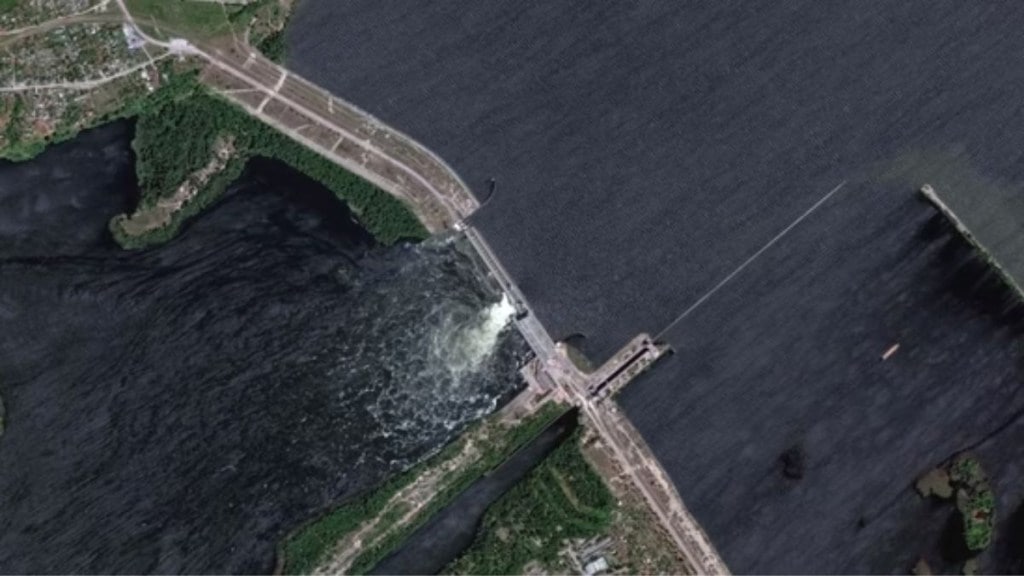The collapse of Ukraine’s Kakhovka dam was a fast-moving disaster that is rapidly progressing toward a long-term environmental catastrophe. Experts noted that the short-term dangers of the destruction of the Kakhovka Dam can be seen from outer space — tens of thousands of parcels of land flooded, however, the long-term consequences — affecting drinking water, food supplies and ecosystems reaching into the Black Sea, will be generational.
The collapse of the Kakhovka reservoir in south Ukraine has left thousands of fish gasping on mud flats, while countless trees and plants drowned in flood waters.
‘Uncertain future’
The draining of the Kakhovka dam on the Dnieper River creates an uncertain future for the region, as the damming of the Dnieper River 70 years ago was arid planning. The 68-year-old dam was the last one in a series of six Soviet-era dams on the river, which flows from Belarus to the Black Sea.
Spanning an area of more than 2,000 square kilometers, the Kakhovka Dam’s reservoir is the country’s largest in terms of water volume. Due to its location, the dam became part of the front line after Russia’s invasion last year and has been controlled by Russian forces since.
Short term dangers
An expert in protected habitats for the Ukraine Nature Conservation Group, Kateryna Filiuta told The Associated Press (AP) that all this territory formed its own particular ecosystem, with the reservoir included.
The breach, which triggered extensive flooding, is being studied extensively by Ihor Medunov who has been very much part of this ecosystem. Medunov’s work as a hunting and fishing guide effectively ended with the Russian invasion of Ukraine, however, he stayed on his little island compound with his four dogs as it seemed safer than the alternative.
The fact that the Russian forces controlled the dam downstream worried Medunov for months. Soon after the Russians seized the historic dam, the whole system fell into neglect. As the Russian forces allowed water levels in the reservoir to fluctuate uncontrollably. In winter, the water levels dropped dangerously low and then rose to historic peaks when snowmelt and spring rains pooled in.
In an interview with AP, Medunov expressed his worry and said that he is watching his livelihood literally ebb away. The waves that stood at Medunov’s doorstep some days ago are now a muddy walk away. “The water is leaving before our eyes,” he said, adding that everything in his house, what he worked for all his life, is all gone. “First it drowned, then, when the water left, it rotted.”
The rushing waters from the reservoir have uprooted landmines, torn through caches of ammunition, and carried 150 tons of machine oil to the water bodies. The breach also resulted in entire towns being submerged to the rooflines in flood waters, and thousands of animals dying in a large national park now under Russian occupation.
The aerial view of the city shows the scale of the Dnieper’s new pollution problem. Meanwhile, Ukraine’s Agriculture Ministry informed that around 10,000 hectares (24,000 acres) of farmland were underwater in the Kherson province, which is controlled by Ukraine, and “many times more than that” in regions occupied by Russian forces.
The mayor of the village of Maryinske, Dmytro Neveselyi said that the farmers are already feeling the pain of the disappearing reservoir, adding that the community of 18,000 people will be affected within days. “Today and tomorrow, we’ll be able to provide the population with drinking water,” he said. “The canal that supplied our water reservoir has also stopped flowing,” he added.
Long term consequences
The receiving water levels unveiled the environmental catastrophe looming. To evaluate the damage, the Ukrainian authorities are also testing the level of toxins in the muck. The reservoir was the last stop along hundreds of kilometers of a river that passed through Ukraine’s industrial and agricultural heartlands. For decades, the flow of the reservoir carried the runoff of chemicals and pesticides that settled in the mud at the bottom.
According to the AP report, the extent of the long-term consequences depends on the movement of the front lines in an unpredictable war. The report also added that flora and fauna populations will take over a decade to return and adjust to their new reality.
‘Worst environmental catastrophe in Europe since Chernobyl disaster’
Ukrainian Deputy Foreign Minister Andrij Melnyk termed the collapse of the dam “the worst environmental catastrophe in Europe since the Chernobyl disaster.” He also added that the aquatic life that is dependent on the reservoir “will lose the majority of their spawning grounds and feeding grounds.”
He also added that there are about 50 protected areas, including three national parks downstream of the reservoir that can be affected by the damage.
The report also stated that various regions of Ukraine will have to grapple with the consequences and mull over the point – whether to restore the reservoir or think differently about the region’s future, its water supply.
The report further quoted Kateryna Filiuta explaining that the worst consequences will probably not affect us directly, not me, not you, but rather our future generations, because this man-made disaster is not transparent. “The consequences to come will be for our children or grandchildren, just as we are the ones now experiencing the consequences of the Chernobyl disaster, not our ancestors,” he added.
(With AP Inputs)

